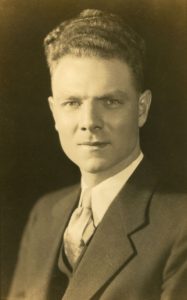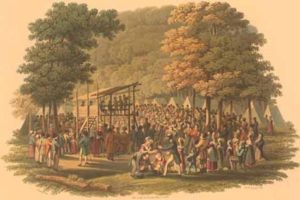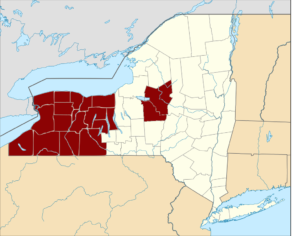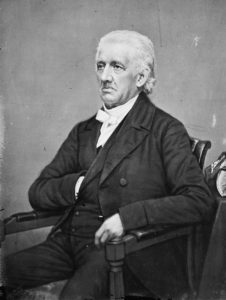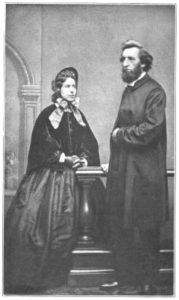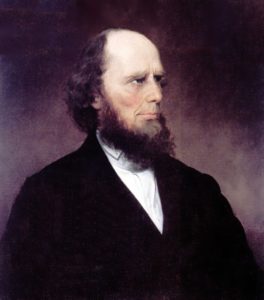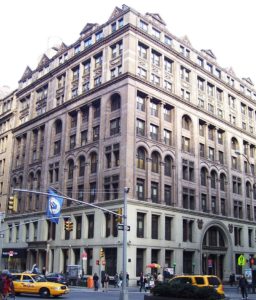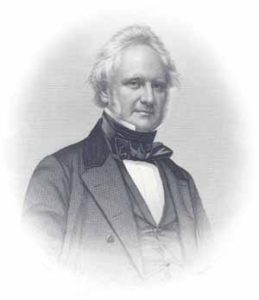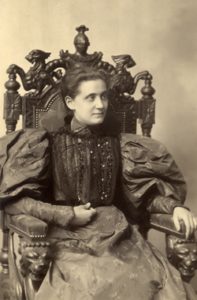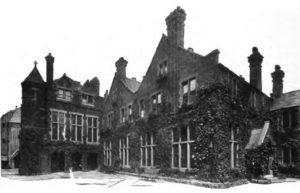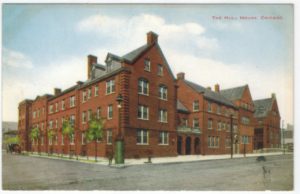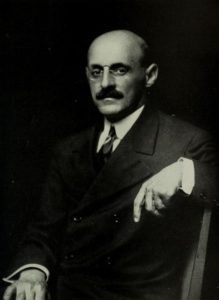Yet again I am wont to say those who have not read Theme 1’s “Wings of Community Development” are likely to be left wandering in the desert. This module builds upon that module. The bottom-line is my approach to Community Development is firmly lodged in its belief that modern 21st Century Community Development is an “umbrella-like” big tent under which at least five different, yet related, “wings” seek shelter–and attempt, so far unsuccessfully, to seek coherence. Lest this be thought of as a criticism, as indeed it is, it is also the chief strength of CD: its decentralized multi-wing bases which like a pillow absorb the deficiencies, ebbs and flows, and the punches of life’s (and times) outrageous fortunes.
In the last module I discussed the First Wing–focusing on its New England Brahmin Elect–and its success in adapting to the democratic mass-based politics of Early Republic. In this module, I present the Early Republic and Gilded Age birth of the Second Missionary-Foundation Wing–in many ways an offspring of the First–and then move on in the next module to a totally different Third Wing: the Social-Economic-Political Mobilization Wing.
Second CD Wing: Missionary-Foundation:
The deepest roots of CD’s Second Wing, like those of the Elect First Wing, were planted by Yankee Puritans. That Puritanism quickly exhibited tension between its Protestant-work ethic-driven Yankee businessmen, and its religious leadership and their devout followers. Over centuries, the Yankee Elect bifurcated on an individual level between those more religiously-inclined, and those less so. The latter are today’s stereotypical neo-liberals, and the former are desendents of today’s Second Wing.
At the start of the Early Republic, potential Second Wingers were religiously-inspired missionaries. By the end of the Early Republic, secularization removed religious doctrines, but did not temper its moralistic fervor, leaving strong overtones of sin, character deficiencies, and bad decisions—and left to Second Wing adherents the now not-heavenly responsibility for rendering assistance to this rather troubled lot. In short order, Second Wing reformers distinguished the “worthy poor” from those unsuitable for their attentions. Changing worthy poor behavior, and improving upon their character and values were Early Republic manifestations of how this wing went about “empowering” the disadvantaged, the worthy poor of the Early Republic’s emerging Big Cities.
In the beginning, Second Wing followers and leadership were drawn from New England’s religious community, and the religiously-inclined Elect. That changed greatly with the onslaught of the Second Great Awakening (1790 ish).
That profound revival movement gained considerable momentum by 1800, spreading from its rural origins into Yankee Diaspora-created new cities and the older East Coast Big Cities. The Awakening climaxed during the 1820’s and tapered off after that–and after that period secularization was increasingly evident. A second generation embraced Second Wing urban missionary commitment, retaining much of the Second Great Awakening’s moralist fervor, but enlarging its membership base to include its upper middle class offspring. Early Republic northern urban social reformers were disproportionately drawn from evangelical New England and Yankee Diaspora Protestants (“burnt over district”, Erie Canal rural areas (1817-25), and Western Reserve of Ohio)”[i].
Early Republic Second Wingers first appeared in Big Cities neighborhoods around 1810. The inescapable trigger of economic panics–and the resulting distress and inequality, probably motivated formerly religious missionaries to launch an “urban ministry”. After the late 1840’s increasing rates of immigration incrementally enlarged their target population. These urban ministries were financed by donations from the religiously-inclined First Wing Elect—many of whom were active in financial supporters of the various religious missions associated with the Second Great Awakening’s “benevolent empire”. Both First Wing Elect and Second Wing overlapped considerably with an exceedingly large number of Third Wing social reform movements, such as Temperance, Suffrage, Abolitionism, and even Phrenology.
The style of antebellum [social] reform in its initial stages was very much that of evangelical Protestantism, with a leavening of rhetoric from the American Revolution and a dash of economic and scientific thought … In the 1820’s and 1830’s reformers usually thought they were attacking sins, not social problems, and they urged individual repentance rather than legislation and coercion. By the 1840’s that began to change … The ineffectiveness of [previous] voluntarism and moral suasion [however] pushed reformers into advocating diverse forms of governmental action[ii].
The ineffective voluntarist organizations/initiatives to which the quote refers, are the first recognizable Second Wing CDOs. Offspring of what Dr. Ronald Walters called the evangelist Protestant missionary “benevolent empire”, relatively sophisticated religious organizations formed in the later years of the Second Great Awakening. Dedicated to proselytizing Protestantism into every nook and cranny (including every region and foreign lands such as Hawaii and China). Examples included the American Bible Society, American Tract Society, American Anti-Slavery Society, Sunday School Union, and American Board of Commissioners for Foreign Missions. These organizations were the training ground, and often the earliest funders of the Second Wing CDOs.
These “evangelical organizations propagated the same world-view, tapped the same financial resources, and had many of the same men on their boards of directors. They often held their conventions at the same times, in the same cities”. They were quite experienced in interdenominational cooperation and coordination and functionally played roles very similar to today’s CD-related philanthropies and foundations. “The driving forces of the benevolent empire were people like Arthur and Lewis Tappan, wealthy New York merchants who were at the center of nearly every one of the greatest religious and secular reforms of the day”[iii].
Among the very first of these Big City CD Second Wing CDOs was the New York City’s Society for the Prevention of Pauperism. Founded in 1817, the Society “investigated both economic and moral aspects of slum life, suggested changes in city-run institutions, and opened savings banks to encourage thrift. It also sent out home visitors … gathered statistics … and sold firewood cheaply to poor families”[iv]. Shades of South Shore Bank.
Often relegated to the pejorative classification of private charity, these early organizations can be considered the first American CDOs. That their world view was, in today’s terms, surprisingly Privatist and supportive of the evolving capitalist system is proof positive that in the Early Republic, indeed throughout the 19th Century the CD Second Wing focused on helping the people they served, and serving them so that they would prevent social (and political) instability. The Society was not the only such organization of the period. Indeed …
Within a few decades Americans had formed a variety of voluntary agencies to help their destitute and deserving fellow citizens (always drawing a distinction between the worthy and unworthy poor…) By the end of the first quarter of the nineteenth century (1825) … over a hundred relief organizations appeared in New York City alone”.[v]
Without any conceptual reason for centering their efforts at the neighborhood level—other than that’s were the distressed lived—the Second Wing began a long tradition of concentrating its activities in neighborhoods. The Society distanced itself from City Hall, and they distinguished themselves from other more religious charitable organizations of the time (like the YMCA or the Salvation Army) [vi]). They focused less on “Christmas turkeys” or relieving physical distress, than changing individual behavior, personal values, and improving individual’s quality/capacity to make “correct” decisions.
As time passed by, however, the Society recognized the deeper roots of the core problem—that the environment in which the poor lived contributed greatly to their distress. That concern with the environment of the urban poor inspired a gradual involvement with reforms that easily intruded into politics and economics. Having entered the neighborhoods of the East’s urban poor,
“these urban missionaries increasingly gave attention to the social factors that kept people from escaping the slums—unhealthy food and housing, bad family life, evil companionship, unemployment and ignorance. The notorious first report of the New York Magdalen Society (founded 1830) explained that much of prostitution was ‘the result of sheer necessity, poverty, rather than preference”.[vii]
The outcry against this report was so intense, the Society formally disbanded–though informally (led by Mrs. Charles Grandison Finney, whose husband is considered the founder of modern revivalism and a major leader of the Second Great Awakening) the Society continued its work.
All this suggests to me the close correspondence of Early Republic Second Wing with today’s “Faith-based” CD. Called “social Christianity” or “social gospel” at the time, it was personified by Washington Gladden (1836-1918), a Congregationalist minister raised in Oswego (“burnt out district”), educated at Williams, who is now acclaimed as its “father”. Deeply concerned with the plight of working men and with urban blight, he stressed it was a Christian’s responsibility to become involved, and to redress abuses and poverty. As a well-known labor mediator, Gladden also worked closely with the civic association movement (see Third Wing module) to popularize that commitment.
The consequences of the Panic of 1837 led to a Second Wing resurgence and formalization. The New York City Association for Improving the Condition of the Poor (founded 1843) serves as an excellent example of the type of CDO founded in that period (as do the 1853 NYC Children’s Aid Society and 1843 Norfolk VA Association for the Improvement of the Condition of the Poor) (Goldfield/ Brownell, p. 164). The Panic of 1837 caused such profound urban misery, it prompted changes in CDO activities and sharpened its policy focus. It also inspired a raft of new CDOs.
The New York City Association for Improving the Condition of the Poor internalized old-style religious fervor and missionary tendencies,and channeled it to resolving the hard realities of Panics and the ineffectiveness of past initiatives. It is now one sees an increased reliance on rationality/science in the form of data analysis to tackle physical and social-psychological pathologies concomitant with poverty and slums[viii]. Juvenile delinquency was identified as a primary concern —as it remained for more than a century when it motivated the Ford Foundation ‘gray areas” experiments. Home visits assumed a “case manager” functionality. The Association lobbied for governmental action, and served as intermediaries with governmental agencies. Secularization and rational-based policy professionalism can be traced from these years. These CDOs continued into the 1850’s and then became enmeshed into the humanitarian (nursing) and abolitionist ferver engendered by the Civil War.
Observations on Early Republic Second Wing as an Intro to the Gilded Age
The shift from religious urban missionary toward a more secular “enlightened outsiders” armed with “scientific” analysis which if followed would improve the lot of the poor by changing their environment and empowering them as individuals deserves additional comment. This shift carried with it overtones of social class, “experts”, “elites”, and seemingly questioned quality/usefulness of working class values, priorities, decisions, and behaviors. Forty or so years later, settlement houses, and two generations later that by the new profession called social work rose out of Second Wing experience. Social work was the first of several professions that arguably got their start from the Second Wing. While professionalism has many, and probably more important drivers, the overlap between the two has played a role in the evolution of the Second Wing.
Also, without making a major issue of it, 19th century CD Second Wing’s birth was a reaction, almost a byproduct, of northern hegemonic Big City urbanization and industrialization. Immigrants, when they appeared, compounded the development of the Second Wing–whose early efforts were centered on nativist neighborhoods. Immigrants from day one turned to their own Third Wing CDOs, rather than collapse their interests with the Second Wing. Immigrants became a second target (after nativist urban poor) for the Second Wing’s tender mercies. This was not always to the immigrant liking. Partly, it can be suggested the immigrant tendency to form Third Wing movements/CDOs were themselves caused by the Second Wing itself.
In 19th century real life, the relationship between immigrants (often Catholic) produced friction with Protestant Second Wing social reform missionaries. Outright tension, and perceived cultural gaps between the two were evident to each. When pockets of Blacks in neighborhoods were encountered in these years, frustration on both sides limited Second Wing effectiveness. The Protestant religiously motivated Second Wing were “social reformers”—funded by moralistic “Elect Brahmin” capitalists, who frequently “deplored” Papist immigrants believing them, in a social Darwinian sense as an inferior race and “labor radicals”. The Second Wingers never satisfactorily distanced themselves from an often hostile Brahmin First Wing.
Neither, the Brahmin Elect and the secularized Second Wing warmed up to unions or ethnic political machines. Their antipathy to Catholic Church, and disgust for the perceived dearth of immigrant teetotalers (i.e. temperance), laughable as that may seem today, drove a wedge between First and Second Wingers and the immigrant community–a wedge the more creative First Wingers bridged, but drove the Second Wingers to follow a variety of “reform paths” such as housing, schools-playgrounds-recreation, social services, neighborhood planning, juvenile delinquency and even building new cities–many of which paths eventually matured into the CD Fifth Wing.
Each of these future social reform manifestations followed from the Second Wing’s secularization, a secularization which many a cynic would suggest merely substituted science, rationality and its modern priesthood–professional experts–for God and religion.
At root in all of these future CD evolutionary offspring, one can also see socio-economic class at play. The interplay between class, adherence to rationality and “experts”, and missionary-moralist fervor has continued to dog the Second Wing into the present-day Contemporary Era. Fortunately for them, Brahmin-Elect economic success provided the resources for their sustained viability.
Gilded Age Second Wing
Remembered as “the Long Depression”, the Panic of 1873 triggered an explosion of relief programs, most prominently the settlement house, whose principal beneficiary were new European immigrants, living in the hellholes of older housing in seriously-distressed urban neighborhoods. Jane Addams’ Chicago Hull House (1889), aka “the settlement house”, is the best known, but not the first. The original idea, pioneered in 1884 by London’s East End Toynbee Hall was imported to New York City by Stanford Coit in 1886 (Neighborhood Guild) was America’s first. Coit worked with Lower East Side Jewish immigrants. Graham Taylor (Chicago Commons) and Robert A. Woods (Boston’s South End House) followed his example.
Settlement houses staffed by middle/upper class volunteers (mostly female) who resided on site offered workshops, counseling, and outreach. The ultimate hope was to instill middle-class “American” values, that if practiced would attack poverty and facilitate assimilation into American society and economic life. Volunteers were expected to serve as role models, and their comprehensive array of services were intended to educate, enhance the quality of immigrant life (e.g. recreation), amd relieve individual/family distress. Settlement houses introduced formally an important defining characteristic of Second Wing CD: “comprehensiveness” of social services as an attack on poverty, whose ultimate purpose was assimilation.
Services offered in settlement houses varied, but the laundry list included: English classes, civics, cooking, sewing, dressmaking, wood and sheet-metal working, legal aid, employment counseling, laundry facilities, baths, some health care, nurseries for working mothers, recreation, athletic programs, concerts, theatre, and even vegetable gardens. Providing such a cacophony of services, reflected an instinctual awareness that transformative personal change required a vast array of services, facilities and education—i.e. “comprehensive”.
Comprehensiveness dilutes the Second Wing’s priority on employment. This reminds us that Second Wing’s highest priority was not economic, rather it was assisting “people”—harkening back to Winthrop’s “city on a shining hill”. But there was one important thread, exposing the Second Wing’s acceptance of industrial capitalism, and its close relationship of the top echelon of American wealth: its fear inequality–poverty–if not checked–threatened stability of the American “order”. Social change through assimilation, not radicalism nor revolution. Accordingly, The settlement house “was an effort to build a bridge of understanding between the [upper] middle classes and the inner-city poor”.
Their non-profit boards of directors were predominately affluent Progressives. Settlement volunteers, contributors, and boards of directors did not identify with and always remained class outsiders to immigrant neighborhoods. Yet, settlement houses were intended to be transformative vehicles, not only for the immigrant, but were also a strategy, if applied on a national scale, to transform northern urban Big Cities. Settlement houses were never mere apolitical or even charitable neighborhood-based service centers. Instead they were “spearheads for reform” (Davis, 1967). The aggregate of settlement houses, it was hoped, could create sufficient scale, leading to meaningful systemic urban social reform. This never happened in the nineteenth century.
Too others, however, assimilation meant social control by business elites and Ivy League settlement house maternalism. Many neighborhood residents identified with and primarily relied upon machine ward politicians and ethnic churches. Residents usually regarded settlement workers as “useful do-gooders” providing an awkward “safety net”. Writer Jack London, no friend of the settlement movement, said settlement house volunteers “do everything for the poor except get off their back … They come from a race of successful and predatory bipeds who stand between the worker and his wages and try to sell the worker what he shall do with the pitiful balance left to him” (Bremner, 1964, p. 65). Trolander, more charitably, observed settlement workers “work for, but is not of” the neighborhood.
Thus the present-day “neighborhood movement”, I suggest, does not follow from this Second Wing, despite its obvious concern with neighborhoods. The bottoms-up contemporary neighborhood movement grew out of Third Wing (see below) mobilization. What would result from settlement houses is a half-century of activist expert-led, middle-class rational-based initiatives (usually neighborhood-level) that eventually migrated into CD’s Fifth “professional-based” Wing. That and foundations and philanthropy. We shall pick up that in Theme 3.
Still, contemporary community developers owe much to the settlement house movement, however. That heritage includes (1) focus on “distressed people, and “the needs of low income neighborhoods”; (2) provision of direct and “comprehensive” array of services to neighborhood residents; (3) an ultimate purpose to alleviate underlying causes of poverty and social pathologies on a national scale by applying rational, planned, often experimental initiatives and (4) an outlet for First Wing Elect with sympathies, guilt, or sincere concern for society’s distressed. More than being the conscience of MED, Second Wing CD tasked itself to ensure capitalism’s inequalities did not institutionalize themselves, thereby freezing vast numbers into chronic poverty unable to rise, to assimilate into the upper echelons of American society and economy. That bottomline task or goal endured through the 20th century. The 21st century, however, becomes a bit more complicated.
The peak of the settlement house movement was just prior to World War I. In 1913, 413 settlement houses operated in 32 states (Trolander, 1987, pp. 3-4). After World War I, settlement house volunteers were replaced by professionally-trained social workers (with newly minted MSWs)—implementing New Deal welfare and social programs in a new profession of social work.
Professionalization of social workers is early evidence of this history’s larger concern with the impact of “siloization” on the coherent identity of American S&L ED. “Spawning” of professions related to, and involved in ED/CD, gas fragmented our professional cohesiveness, encouraged micro-splintering in programs, EDO-types, and strategies which by the 21st century populate our jurisdictional policy systems, inhibiting our ability to forge a critical mass sufficient to reverse urban and regional decline. Perhaps seemingly out of place for some readers, this warning is perhaps an awkward way to introduce this phenomenon, but it does serve as a segue way to Theme 3’s discussion on CD’s Second Wing.
FOOTNOTES
[i] Ronald Walters, American Reformers 1815-1860, consulting editor Eric Foner (Hill and Wang, New York, 1978), p. 4.
[ii] Ronald Walters, American Reformers 1815-1860, consulting editor Eric Foner (Hill and Wang, New York, 1978), p. xi.
[iii] Ronald Walters, American Reformers 1815-1860, consulting editor Eric Foner (Hill and Wang, New York, 1978), p. ix.
[iv] Ronald Walters, American Reformers 1815-1860, consulting editor Eric Foner (Hill and Wang, New York, 1978), p. 214.
[v] Ronald Walters, American Reformers 1815-1860, consulting editor Eric Foner (Hill and Wang, New York, 1978), pp. 33-5.
[vi] Ronald Walters, American Reformers 1815-1860, consulting editor Eric Foner (Hill and Wang, New York, 1978), pp. 174-5.
[vii] Ronald Walters, American Reformers 1815-1860, consulting editor Eric Foner (Hill and Wang, New York, 1978), p.175.
[viii] I believe it interesting that 1840’s community developers did not toss aside their religious values in dealing with the poor. Walters (pp. 177-9) observes the distinction between deserving/undeserving poor was core, as was the bottom line belief that poor decisions and misplaced priorities led to poverty—not unlike neo-conservative positions of the mid-20th century. Yet by the eve of the Civil War he observed CDO moved “a half-step” toward the view that prevailed in the 20th century: the belief that social conditions, not just personal morality, have to be changed, and that the state has the responsibility to do the job” (179). This view, one could suggest radically changed in the 21st century, our Contemporary Era, when discrimination and inequality became the casual factors for poverty and social pathologies, not environmental, physical barriers, or personal decisions and morality.
[ix] Ronald Walters, American Reformers 1815-1860, consulting editor Eric Foner (Hill and Wang, New York, 1978), p.180.
[x] Ronald Walters, American Reformers 1815-1860, consulting editor Eric Foner (Hill and Wang, New York, 1978), p.180.

